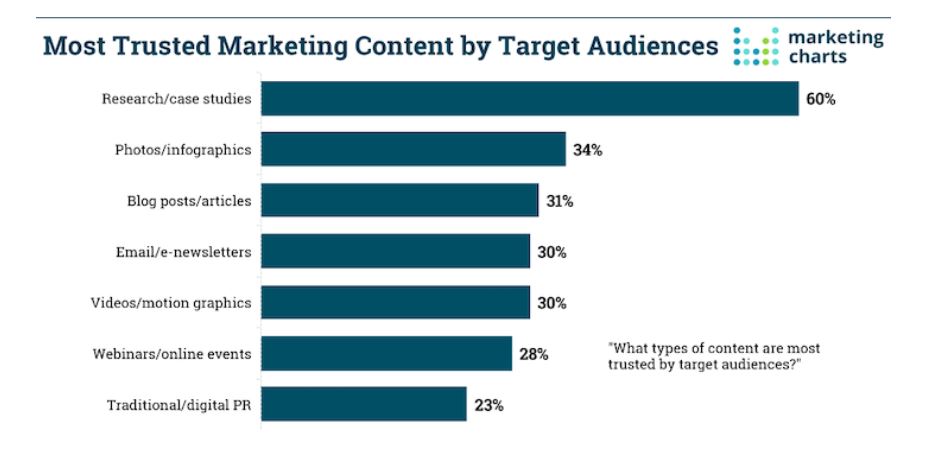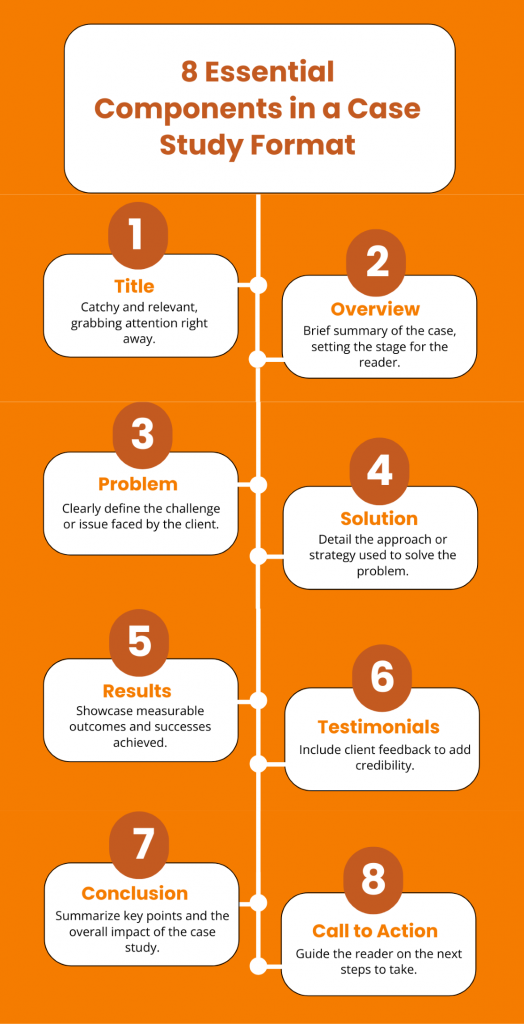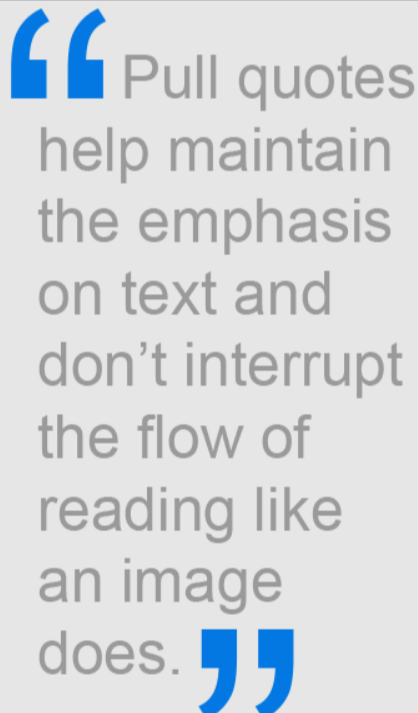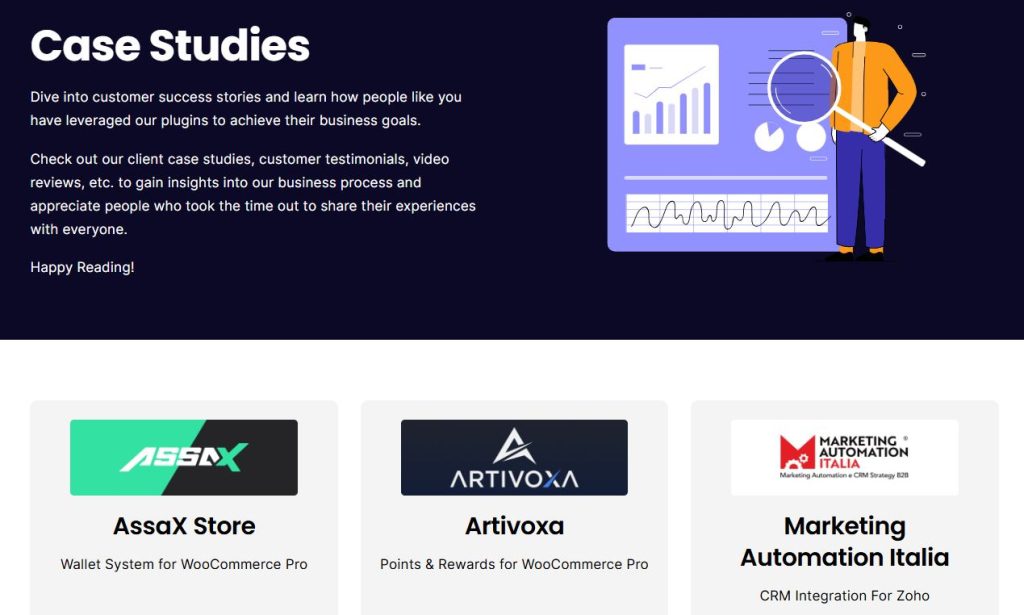
Case studies are one of the most powerful trust-building tools a business can use. They show real stories from real clients. They reflect the value you deliver in a way that no sales pitch ever could. When visitors see a well-crafted case study on your website, they get proof. Not vague claims or abstract benefits. Proof of how your product or service made a difference.
However, many businesses keep these stories hidden on hard-to-find pages. Others overcomplicate the layout. Some go too heavy on jargon or long paragraphs. None of that helps your potential customers. To truly make an impact, case studies must be easy to find, visually engaging, and written in a narrative style, not a report format.
Here’s how.
In This Blog, We Will Talk About…
- 10 Ways To Display Case Studies on Your Business Website
- Make Case Studies Easy To Discover
- Structure Them Like A Story, Not A Resume
- Write In A Storytelling Tone
- Highlighting Key Points of the Case Studies
- Use Pull Quotes>
- Use Visuals to Show, Not Just Tell
- Create a Dedicated Case Study Section
- Link Case Studies with Relevant Services
- Keep Your Case Studies Updated and Authentic
- Don’t Hesitate to Talk About Failures and Mistakes and Your Takeaways from Them
- Frequently Asked Questions (FAQs)
Make Case Studies Easy To Discover
People don’t go looking for case studies unless you lead them there. If your case study lives deep inside your site, only the most determined will find it.
So think of case studies as front-page content. Include a “Success Stories” section on your homepage. Put a few featured case studies on your product pages. Mention them in your blog posts when relevant. The idea is to treat them as proof, not just extra reading material. Use preview images, client names (with permission), and clear call-to-action links. Make them a natural part of your site’s user journey.
Did you know that case studies are among the most trusted content types, according to 60% of marketers. This makes it 10 times more significant to include it as a marketing activity.
Structure Them Like A Story, Not A Resume
Case studies often become long walls of text. Readers don’t enjoy those. They skim and scan, bouncing if it feels too dense.
Start with a brief overview. Mention the challenge your client faced, what your business did, and the outcome. Then go deeper. Use clear subheadings like “The Challenge,” “Our Approach,” and “The Results.” Keep your language human. This isn’t a white paper. You’re not writing for a boardroom.
Include quotes from the client. Real voices add credibility. They also bring warmth and depth to the piece. A short quote can say more than a whole paragraph sometimes. End the case study with where the client is now. Growth. Improvements. Peace of mind. Whatever success looked like for them, capture it.
Write In A Storytelling Tone
People don’t remember stats; they remember stories. Your case studies should feel like someone sharing their journey, not reporting a quarterly update.
Think of your client as the main character. What problem did they face? How did they feel at that moment? Describe it simply, like a scene in a book. Then introduce your business as the helpful guide, not the hero. Focus on what changed, what worked, and how life improved afterward. Use words that feel human, not robotic or overly polished. Readers relate to struggles and real progress, not just perfect outcomes.
A storytelling tone keeps people reading. It invites them to connect. And most importantly, it helps them imagine their own success story.
Highlighting Key Points Of The Case Studies
Your reader is busy. They might not read the entire story. That’s okay. Your job is to make the takeaway moments obvious and easy to grasp.
For instance, assume that you run a law firm. On average, US attorneys charge clients around $327 per hour. In some places, like DC, lawyers will charge $392 per hour. Hence, since you’re charging so much, you would want to build trust with your potential client. And one of the most effective ways to do so is by showcasing case studies.
The structure of your case study matters just as much as the content. Rather than rambling descriptions, focus on three to four key elements: the client’s problem, your legal strategy, the resolution, and the client’s reaction. These focal points help visitors quickly grasp the value of your work without having to read paragraphs of dense legal detail.
For example, if your law firm has handled cases related to the Depo-Provera lawsuit, that’s a powerful story to tell. According to TorHoerman Law, thousands of women experienced serious risks due to using Depo-Provera as a birth control method. As a result, the Depo-Provera lawsuits surged across the country. With growing cases of the Depo shot linked to brain tumors, legal action had to be taken. Many top law firms took on the responsibility of delivering justice and compensation to the Depo-Provera victims.
If your firm handled this case, you can lay out how your firm handled it. Perhaps you guided a client through the complexities of healthcare providers’ responsibilities, potentially recommending they ask experienced healthcare app developers about creating compliant patient-facing platforms. Or maybe you helped them navigate the delicate arena of Depo-Provera lawsuit settlements. People who skim such studies should be able to walk away with the core message in under a minute. That, in turn, will also enable them to understand how your business operates, deals with clients, and addresses challenges.
Use Pull Quotes
Pull quotes can breathe life into your case studies. These are short snippets of client feedback or impactful lines pulled from the story and styled to stand out.
When used well, pull quotes draw the reader’s eye and give them an emotional checkpoint within the text. Imagine a visitor skimming your case study. A powerful, honest quote can make them pause. It adds rhythm to the story and reinforces the human side of your business.
Choose lines that speak directly to the transformation the client experienced. Avoid generic praise. Instead, focus on specific moments of relief, success, or surprise. That’s what resonates.
These quotes not only break up the layout but also build instant credibility without overwhelming your reader.
Use Visuals To Show, Not Just Tell
People remember visuals better than text. A good case study layout uses images, charts, or snapshots of results. This isn’t decoration. It’s storytelling. Some use videos as well. After all, videos are better at grabbing attention compared to textual content. Collaborating with a b2b video production company ensures your videos are professionally crafted to highlight key messages and resonate with your audience effectively.
If your product increased sales by 300 percent, show a simple chart. If your service led to a stunning design transformation, include before-and-after shots. Maybe your construction company built a house in adverse weather. Why post a time-lapse video of the construction work? Screenshots of dashboards or performance metrics also work well. As long as you blur out anything sensitive, you can make numbers feel more alive.
Also, feature a photo of your client, if they’re comfortable with that. It brings instant credibility. Readers connect with faces faster than words.
Create A Dedicated Case Study Section
Some visitors come to your site just to see who you’ve worked with. A dedicated case study page can help them. Design this section like a small gallery. Each case study should have a title, a photo or “logo design“, a one-sentence summary, and a link to “Read More
Don’t list too many on one page. That overwhelms the user. Keep it clean and focused. Group them by industry, service, or result if that makes sense for your business. When someone clicks into a case study, they should feel they’re entering a well-designed space. This experience says something about your brand. You care about details. You respect your visitor’s time.
Link Case Studies With Relevant Services
Case studies shouldn’t live in a silo. They should support the parts of your website that speak to customer pain points.
On a product page, add a small section that reads: “See how this helped one of our clients.” Then link to the relevant case study. And, on your pricing page, include a testimonial or link to a story that proves return on investment. Don’t rely on the reader to connect the dots. Do it for them.
The more strategic you are with case study placement, the more powerful they become. That means that your case studies become features that enhance the user experience and help you turn interested audiences into paying customers.
Keep Your Case Studies Updated And Authentic
Case studies have a shelf life. If your most recent success story is from 2018, it might make you look outdated. In fact, at times, some success stories from even 2020 or 2022 might feel irrelevant and outdated.
Try to add a new one every few months. Show different types of results. Highlight a variety of industries or business sizes. Authenticity also matters. Don’t exaggerate numbers. Don’t edit client quotes until they lose their original tone. Potential customers are savvy. They know when they’re reading marketing fluff.
If your case studies feel honest, they’ll trust your company more.
Don’t Hesitate To Talk About Failures And Mistakes, And Your Takeaways From Them
Perfection isn’t relatable; growth is. Including failures or early missteps in your case studies can make them far more credible and engaging.
Maybe the first approach didn’t work as expected. Maybe timelines shifted. If you’re honest about those moments, your audience sees you as experienced, adaptable, and trustworthy. No project runs perfectly, and clients know that. What matters is how you handled it.
Did you adjust your strategy? Or, do you communicate clearly? Talk about what you learned and how it shaped your future work. This transparency builds trust and makes the story feel human. It also positions your business as one that values accountability, problem-solving, and long-term improvement over short-term showmanship.
Frequently Asked Questions (FAQs)
1. What is the purpose of business case studies?
- Business case studies are used to showcase how a company addressed a specific challenge or achieved success using a particular strategy or product. They help build trust with potential clients or investors by offering real-world evidence of effectiveness. Case studies also allow businesses to highlight their strengths, decision-making, and measurable outcomes in a compelling narrative.
2. How are business case studies formatted?
- Most business case studies follow a structure: introduction, background or challenge, solution, implementation, results, and conclusion. Some include quotes, visuals, design templates or data charts to support the story. The tone is often professional but engaging, aiming to guide the reader through a problem-solving journey that positions the business as capable and reliable.
3. Are all case studies lengthy?
- No, not all case studies are lengthy. Some are brief one-page overviews or slide decks summarizing key points. Short case studies can be effective for quick reads on websites or social media. The depth and length depend on the target audience and the complexity of the case being shared.
4. How do reading case studies help others?
- Reading case studies helps others by providing real-world examples that offer practical insights and lessons. They allow readers to understand how specific problems were solved, what strategies worked, and what mistakes to avoid. This can be especially useful in fields like business, education, healthcare, or social work, where decision-making benefits from experience. Case studies make theoretical concepts easier to apply in real situations.
5. Are case studies based on real stories or incidents?
- Yes, case studies are usually based on real stories or incidents, though details are sometimes altered for privacy. They present a detailed account of a particular event, challenge, or process to illustrate a broader principle or practice. In academic or professional settings, they are often used to examine how certain outcomes were achieved. This grounding in real events helps make the learning more relevant and reliable.
6. How can you make a case study interesting for your audience?
- You can make a case study interesting by focusing on a compelling narrative that highlights the problem, the journey to solve it, and the outcome. Use clear language, relatable characters, and real data or visuals to keep readers engaged. Including quotes, challenges faced, and unexpected turns can make the story feel authentic. The goal is to educate while keeping the audience emotionally and intellectually invested.
You work hard for your clients and solve real problems. And your website should reflect that with case studies that are easy to find, enjoyable to read, and convincing.
They should feel like real stories. Avoid corporate talk, marketing gimmicks, and lengthy reports. Tell the story of the people you helped. Show how your work changed things for the better. Let your future clients see themselves in those stories.
When done right, case studies become more than content. They become proof that what you offer truly works.












